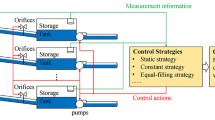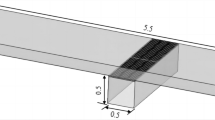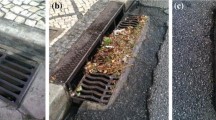Abstract
This paper investigates the effect of rainstorm movement on the peak discharge response (PDR) of drainage networks by comparing it with the corresponding equivalent stationary and uniform rainfall. A synthetic circular watershed is introduced to avoid biases from interaction between catchment geometry and storm orientation. The drainage network of the watershed is simulated by the Gibbsian model to examine the effect of network configuration on the peak response depending on the storm kinematics. This study utilizes two types of the equivalent stationary storm (ESS): the average rainfall intensity over the entire catchment (ESSAV) and the point stationary rainfall intensity (ESSQ) to evaluate the effect of moving rainstorms in terms of the PDR. The results show that there exists an interval in which the same rainfall duration produces higher peak responses for moving storms compared with ESSQ. The augmentation of the peak response by moving rainstorm is dependent on the relative rainstorm speed, size, and direction as well as drainage network configuration of the catchment; especially, the results show that a less efficient network tends to mitigate the effect of rainstorm movement on peak response. In contrast, a more efficient network is more sensitive to storm kinematics and the peak response increases compared with ESS. Therefore, the results in this study imply a potential improvement in urban drainage networks in terms of efficiency as well as safety to moving rainstorms. Also, this study suggests the range of variation in peak flows due to storm kinematics compared with the ESS, which can be a reference to the current design practices.










Similar content being viewed by others
References
Akan AO, Houghtalen RJ (2003) Urban hydrology, hydraulics, and stormwater quality: engineering applications and computer modeling. Wiley, Hoboken
Arnaud P, Bouvier C, Cisneros L, Dominguez R (2002) Influence of rainfall spatial variability on flood prediction. J Hydrol 260(1–4):216–230
Chow VT, Maidment DR, Mays LW (1988) Applied hydrology. McGraw-Hill series in water resources and environmental engineering. McGraw-Hill, New York
De Lima JLMP, Singh VP (2002) The influence of the pattern of moving rainstorms on overland flow. Adv Water Resour 25(7):817–828
De Lima JLMP, Singh VP (2003) Laboratory experiments on the influence of storm movement on overland flow. Phys Chem Earth 28(6–7):277–282
Foroud N, Broughton RS, Austin GL (1984) The effects of a moving rainstorm on direct runoff properties. Water Resour Bull 20(1):87–91
Ising E (1925) Beitrag zur theorie des ferromagnetismus. Zeitschrift für Physik A Hadrons and Nuclei 31(1):253–258. doi:10.1007/bf02980577
Karlinger MR, Troutman BM (1989) A random spatial network model based on elementary postulates. Water Resour Res 25(5):793–798
Kindermann R, Snell JL (1980) Markov random fields and their applications: contemporary mathematics, vol 1. American Mathematical Society, Providence
Lee MT, Delleur JW (1976) A variable source area model of the rainfall–runoff process based on the watershed stream network. Water Resour Res 12(5):1029–1036. doi:10.1029/WR012i005p01029
Lee KT, Huang JK (2007) Effect of moving storms on attainment of equilibrium discharge. Hydrol Process 21(24):3357–3366
Liang J (2010) Evaluation of runoff response to moving rainstorms. Marquette University, Milwaukee
Moussa R (2008) What controls the width function shape, and can it be used for channel network comparison and regionalization? Water Resour Res 44(8):1–19
Ngirane-Katashaya GG, Wheater HS (1985) Hydrograph sensitivity to storm kinematics. Water Resour Res 21(3):337–345
Niemczynowicz J (1984a) Investigation of the influence of rainfall movement on runoff hydrograph: 1. Simulation on conceptual catchment. Nord Hydrol 15(2):57–70
Niemczynowicz J (1984b) Investigation of the influence of rainfall movement on runoff hydrograph. 2. Simulation on real catchments in the City of Lund. Nord Hydrol 15(2):71–84
Niemczynowicz J (1991) On storm movement and its applications. Atmos Res 27(1–3):109–127. doi:10.1016/0169-8095(91)90012-l
Nunes JP, de Lima JLMP, Singh VP, de Lima MIP, Vieira GN (2006) Numerical modeling of surface runoff and erosion due to moving rainstorms at the drainage basin scale. J Hydrol 330(3–4):709–720
Ogden FL, Richardson JR, Julien PY (1995) Similarity in catchment response: 2. Moving rainstorms. Water Resour Res 31(6):1543–1547
Rodriguez-Iturbe I, Valdes JB (1979) Geomorphologic structure of hydrologic response. Water Resour Res 15(6):1409–1420
Saco PM, Kumar P (2002a) Kinematic dispersion in stream networks—1. Coupling hydraulic and network geometry. Water Resour Res 38(11):1244. doi:10.1029/2001wr000695
Saco PM, Kumar P (2002b) Kinematic dispersion in stream networks—2. Scale issues and self-similar network organization. Water Resour Res 38(11):1245. doi:10.1029/2001wr000694
Scheidegger AE (1967a) A stochastic model for drainage patterns into an intramontane trench. Int Assoc Sci Hydrol Bull 12(1):15–20
Scheidegger AE (1967b) On topology of river nets. Water Resour Res 3(1):103–106
Seo Y, Schmidt AR (2012) The effect of rainstorm movement on urban drainage network runoff hydrographs. Hydrol Process 26(25):3830–3841. doi:10.1002/Hyp.8412
Seo Y, Schmidt AR, Sivapalan M (2012) Effect of storm movement on flood peaks: analysis framework based on characteristic timescales. Water Resour Res 48:W05532. doi:10.1029/2011wr011761
Singh VP (1997) Effect of spatial and temporal variability in rainfall and watershed characteristics on stream flow hydrograph. Hydrol Process 11(12):1649–1669
Singh VP (1998) Effect of the direction of storm movement on planar flow. Hydrol Process 12(1):147–170
Surkan AJ (1969) Synthetic hydrographs—effects of network geometry. Water Resour Res 5(1):112–128
Surkan AJ (1974) Simulation of storm velocity effects on flow from distributed channel networks. Water Resour Res 10(6):1149–1160
Troutman BM, Karlinger MR (1992) Gibbs distribution on drainage networks. Water Resour Res 28(2):563–577
Watts LG, Calver A (1991) Effects of spatially-distributed rainfall on runoff for a conceptual catchment. Nord Hydrol 22(1):1–14
Yen BC, Chow VT (1969) A laboratory study of surface runoff due to moving rainstorms. Water Resour Res 5(5):989–1006
Author information
Authors and Affiliations
Corresponding author
Rights and permissions
About this article
Cite this article
Seo, Y., Schmidt, A.R. Evaluation of drainage networks under moving storms utilizing the equivalent stationary storms. Nat Hazards 70, 803–819 (2014). https://doi.org/10.1007/s11069-013-0845-1
Received:
Accepted:
Published:
Issue Date:
DOI: https://doi.org/10.1007/s11069-013-0845-1




